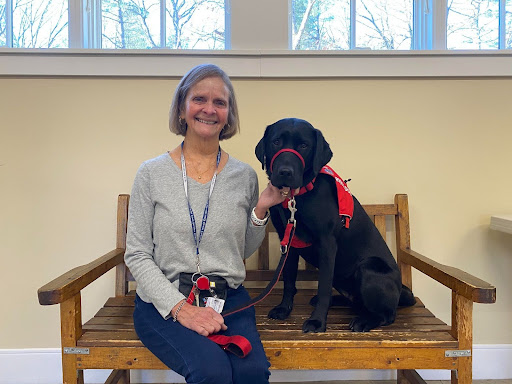
Have you ever wondered about the advantages of having a service dog? If you are living with a difficult medical diagnosis, you might be interested in learning the many tasks a service dog, properly trained, is able to do to help improve the quality of your days. I have learned this firsthand after years of living with Ehlers-Danlos syndrome, a chronic condition that makes life unpredictable and difficult to navigate.
I was very fortunate to be matched with a service dog from the organization called NEADS. At the time that I was accepted into the program, I had been using a wheelchair for four years and needed help to be more independent. Eight months after my initial interview process, the call came in that I was matched to Maggie, and life became magical.
Just eight days after returning from my two-week training with her on campus, I woke up to find her next to me in bed, although she was trained to not move from the floor next to my bed, where I had commanded her to stay. However, I couldn’t scold her, because she had sensed that I had stopped breathing despite using my breathing machine. She had jumped up and proceeded to reposition me until the airflow returned, saving my life. From that day on, the doctor asked that she sleep next to me to keep an eye on me.
She was never trained to alert me in any way—yet just after two weeks of training with me, she already understood when something was very wrong, and she enjoyed taking on the responsibility of helping me. Her loyalty to doing her chores on command and keeping me safe remained for over 10 years until her passing.
After endless waiting, I have now been matched again with my new girl who is full of spunk and a wonderful help with my life. I look forward to many years together with Velma, who was given her name when a person sponsored the organization.
What are some of the tasks a service dog can provide for a person upon command?
- Pick up dropped objects on the floor
- Collect the morning paper
- Open a refrigerator, cabinet, or other door for you using a rope
- Nudge a door closed
- Pick up food bowls
- Nudge a breathing machine located on the floor
- Carry your belongings in their working jacket pockets
- Watch you exercise and be sure you are safe
- Carry an object to another person for you
- Travel at your feet on buses, trains, and airplanes
- Carry your ticket for a trip
- Turn light switches on and off
- Retrieve objects from tables and counters
- Bark on command to alert others that you need help
- Push automatic door buttons
- Retrieve the phone for you
- Sense a medical alert
- Provide tactile stimulation during a panic attack
- Offer grounding or blocking in public areas
- Remain by your side even in a hospital
- Provide the most amazing comfort and support one could ask for
If this is of interest to you, the next thing you need to decide is how you want to consider getting a dog. You can contact organizations that train and match those who are approved, or you can train a dog on your own or with assistance.
Answers to Common Questions
Can you train your own dog?
Under the Americans with Disabilities Act (ADA), people with disabilities have the right to train their service animals themselves; they are not required to use a professional training program for service dogs. There is no legal service animal certification.
How is a service dog defined?
Under the ADA, a service animal is defined as “a dog that has been individually trained to do work or perform tasks for an individual with a disability.” The dog must be trained to take specific action when needed to assist the person with a disability, and to perform tasks directly related to the person’s disability.
It is important to learn the requirements and laws for service dogs. They may be trained to assist with a variety of disabilities, including physical, sensory, psychiatric, intellectual, or other emotional disabilities.
Based on the ADA’s ruling in 1990, dogs that provide a professional service to individuals with disabilities who require their support will be allowed access to public places when accompanying their handlers. This is not limited to seeing eye dogs as is commonly believed.
What are the requirements for service dogs?
- Step 1: Identify and understand what type of dog you have: Any dog breed is eligible for service work. Service dog laws do not include restrictions on breed or weight. If you don’t know the breed of your dog, you can conduct a simple dog DNA test that can provide you with more information about breed-related instincts. You should also be aware of your dog’s health conditions to confirm that the age and health of your dog is suitable for the job, and to prevent adding strain to a service animal’s health and also to its handler’s condition(s). It is also important to test your dog’s personality type to see if he or she has a good temperament for service work. Dogs who are aggressive or easily scared may not work as service dogs until their public temperament improves.
- Step 2: Choose whether to work with a trainer you trust or train your dog yourself: You can opt to either adopt a trained service dog from a reputable trainer or bring your dog to a trainer—but did you know that you can also train your dog yourself under service dog laws? In the United States, there is no required ADA certification for service animal training. The community is self-regulated and includes minimum government-regulated standards for training. Choosing to train your dog yourself can help increase the bond between you and your service dog.
- Step 3: Train your service dog: Most of your time will be spent here. Putting in enough time to train your future service dog is a crucial step. While the United States has no minimum requirement, international standards suggest approximately 120 hours of training over six months. It is recommended that at least 30 of those hours should be time spent in public to help train the dog to respond to distractions and any surprises that may come their way. The most important task for you to teach your service dog is tasking or learning the specific skill or skills they will be performing to help assist with your disability.
- Step 4: The Public Access Test: Once you feel your service dog is trained, it’s time to put them to the test! The full Public Access Test from Assistance Dogs International is available here. Below is a quick list of some of the criteria for your service dog to pass:
- No aggressive behavior
- No response to distractions from noises, smells, or other people
- No solicitations for food or affection
- No over-excitement or hyperactivity in public
- Step 5: Certification and equipping: In the United States, service dog certification and service dog identification are not a requirement. Unfortunately, many public employees and places will still require it. For your convenience, it’s good practice to offer to present documents that can help show that your dog is a trained service dog. This will help prevent situations where you are met with hostility when traveling with your service dog. Electing to carry a custom service dog ID card and service dog vest might be a simpler solution for you and your service dog. You may also choose not to carry the ID card and stand your ground on principle when you encounter people ignorant of service dog rights. After you verbally confirm that your dog is a trained service dog or documentation is shown, reasonable accommodations must be legally made for service dogs. Because service dogs provide help for those facing a physical or mental disability, they are granted access to public places such as hotels, restaurants, and malls. It’s important to understand these steps to help you or those around you.
What questions can people ask me about my service dog?
- Is the dog a service animal required because of a disability?
- What work or task has the dog been trained to perform?
What can people not ask me about my service dog?
- Documentation cannot be requested.
- The dog does not have to demonstrate its tasks.
- The person cannot be asked what their disability is.
Properly trained dogs are polite, quiet, excited to help you, and love their assignments—they generally will not bark in public unless they are doing so to assist their handler. I hope this information gives you some good insight into not only the work that goes behind training a service dog, but also the benefits of reward with successful work.
May life be kind to you…
–by Ellen Lenox Smith
About the Author:
 Ellen Lenox Smith has emerged as a leading voice for patients living with pain. Currently, Ellen serves as Co-Director of Medical Cannabis Advocacy for the U.S. Pain Foundation and is a member of its Board of Directors. She is also active with the EDS RI support group.
Ellen Lenox Smith has emerged as a leading voice for patients living with pain. Currently, Ellen serves as Co-Director of Medical Cannabis Advocacy for the U.S. Pain Foundation and is a member of its Board of Directors. She is also active with the EDS RI support group.
Prior to patient advocacy, Ellen was a longtime middle school social studies teacher. She has been married for 50 years and is the proud mother of four adult children and grandmother to five grandchildren. She also is the author of two books, an organic gardener, and was previously a master swimmer and high school swim coach.
Subscribe to our newsletter
U.S. Pain Foundation is a 501 (c)(3) nonprofit organization dedicated to serving those who live with conditions that cause chronic pain, as well as their caregivers and care providers. Learn more.
Our Sponsors
U.S. Pain Foundation relies on the generosity of donations and grants. We are especially thankful to our Corporate Council for sustaining our programs and services year-round. Learn more.
Contact Us
U.S. Pain Foundation, Inc.
15 North Main Street, Unit 100
West Hartford, CT 06107
Telephone: 800.910.2462
Email:
[email protected]
Tax ID number: 26-2703521
All Content Copyright 2021 | All rights reserved. U.S. Pain Foundation is a qualified 501(c)(3) tax-exempt organization. Disclaimer
